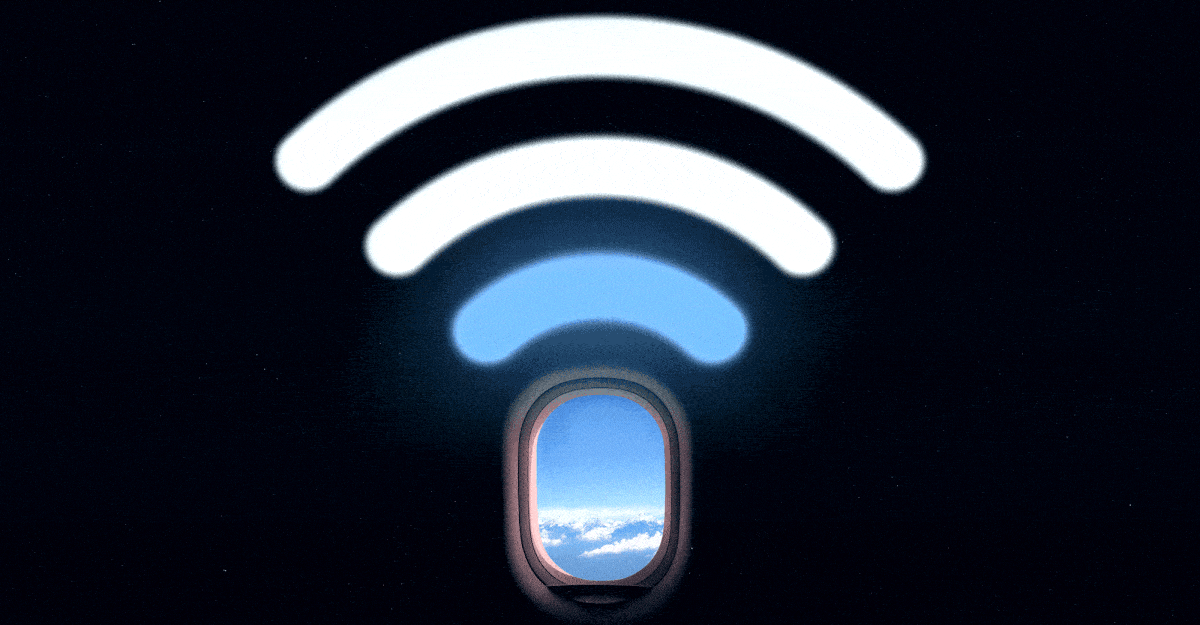“Wi-Fi is available on this flight,” the flight attendant announced on a recent trip I took from New York City to St. Louis. She recited her routine by rote, and Wi-Fi is among the details that now need to be conveyed, along with explaining how to use a seatbelt and enjoining passengers not to smoke e-cigarettes on board.
But when the time came to use the Wi-Fi, the service didn’t work. Eventually, enough people noticed this that the crew “rebooted” it, after which it still didn’t work. A new announcement acknowledged that Wi-Fi was, in fact, not available on this flight (and offered an apology). This was the can’t even access the portal kind of failure, but I’ve frequently encountered others, including can log in but not connect and so slow as to be worse than nothing. And then, at other times, the internet works great—as reliably as it does in an office building.
For two decades now, in-flight Wi-Fi has occupied this limbo between miracle and catastrophe. Way back in 2008, on Conan O’Brien’s late-night show, Louis C.K. told the story of a man who was complaining about the in-flight Wi-Fi not working mere moments after learning of its existence. “Everything is amazing right now and nobody’s happy,” the comedian joked. The bit was never quite right—nobody was happy, because services such as in-flight Wi-Fi were not yet amazing, actually. A chasm separated the service’s promise and its reality.
Today, 17 years later, I sense that same distance when I try to go online in the air. The matter feels more urgent now that more airlines, including JetBlue, Delta, and soon American and United, are offering free, purportedly better in-flight Wi-Fi (mainly to loyalty members so far). Air travel is neither a haven for offline delight nor a reliable place to carry out normal online life. Either option would be welcome, because each would be definitive. Instead, one is left to wonder if the hours about to be spent in flight can be filled with scrolling, shopping, Slacking, and tapping at Google Docs—or not.
I set out to learn why. Is the issue technological? Are the airlines promising more service than they can deliver? Most of all, I wanted to know if this situation will ever be fixed, making airplane Wi-Fi feel as brisk and reliable as it does elsewhere. The answer, it turns out, is familiar: soon, any day now, probably next year.
* * *
Because it’s the thing they use most often and turn on directly, people use Wi-Fi as a nickname for internet access in general. (“The Wi-Fi is down,” your spouse or child might say.) But the Wi-Fi part of airplane Wi-Fi—the access points in the plane that appear as “Delta Wi-Fi” or whatever on your computer or smartphone—is almost never part of the problem. Instead, the problem is the pipe to which the Wi-Fi connects—the in-flight equivalent of the cable or fiber that delivers internet service to your house.
An airplane flies in the air, and there are two ways to get the internet to connect to such a place: from above or below. At first, the only option was down. If you’re old enough to remember the September 11 attacks, you might also recall the Airfone service on some airlines—a phone handset stuffed into the seatback. These phones used air-to-ground communication, meaning that the signal was sent from the plane to a relay on the ground. Airfone (and its competitors) were expensive, didn’t work well, and few people used them. But that technology would be repurposed for early in-flight internet, offered via providers such as Gogo Inflight.
Jack Mandala, the CEO of Seamless Air Alliance, a standards organization for in-flight connectivity, told me that air-to-ground works like your cellphone—the bottom of the plane needs a view (metaphorically speaking) of base stations from the air. That’s why, for a time, you could use in-flight internet only over 10,000 feet. It’s also why the service is unreliable. Just like your cellphone might hit a dead spot, so can your airplane. Air-to-ground bandwidth was limited, meaning that the service would get worse as more people on a plane used it. And finally, air-to-ground service operates extremely slowly when it sends data down to the ground—this is why sending an email attachment or texting an image from a plane can take an eternity, before possibly failing completely.
Going up instead of down mostly solved these issues. Around the time of Louis C.K.’s Conan bit, airlines began offering internet service to planes via satellite communication. The improved speed and reliability allowed JetBlue to provide the industry’s first free in-flight internet to commercial passengers, in 2013. According to Mandala, satellite services are easier to scale as more planes adopt them and more passengers use them. Satellite also has the benefit of being usable over water, in bad weather, and on the ground.
The problem is that having viable technology is different from rolling it out seamlessly everywhere. Doing so requires investing in the equipment and service, and that requires time and money. In 2019, Delta, for instance, made a commitment to roll out free Wi-Fi across its entire fleet. Joseph Eddy, the airline’s director of cabin and in-flight entertainment and connectivity, told me that Delta’s effort is still ongoing. Unlike hotels or convention centers, Eddy reminded me, aircraft are highly regulated. Each type of aircraft needs to be configured differently, and a big airline such as Delta—or American, which told me it will also soon have 1,500 aircraft of its own with Wi-Fi service—requires some planning. “We need to make software upgrades. We need to make sure we have all the satellite coverage that we need to ensure that we have enough capacity and the experience is as good as possible,” Heather Garboden, American Airlines’ chief customer officer, told me.
But, hold up: American is the carrier I fly most these days, and I keep finding myself unable to use the internet. Garboden confirmed that American is still transitioning its regional jets to satellite service—many are still using air-to-ground. And that’s exactly the kind of plane I was on from New York. Delta’s Eddy told me that its regional jets and some short-haul planes, including the Boeing 717, are also still operating on air-to-ground service.
In both cases, the airlines made a deliberate choice to invest first in the routes and planes that carry the most passengers—big, mainline jets. That means that if you’re flying on a long flight across or between continents, or on an airline with fewer types of planes, such as JetBlue or Southwest, you might have a better shot at reliable internet. And if you’re on a small or regional jet, chances are greater that the Wi-Fi won’t work, or won’t work well. Eddy told me that Bombardier CRJ regional jets have proved more troubling to certify for the satellite antennas that sit on top of the fuselage, because of the aircraft’s rear-mounted engines. “You can’t allow any form of debris to fly off the antenna at all,” he said. If you board a plane and Wi-Fi isn’t available on the ground, that’s a sign that your aircraft is still using air-to-ground service. Good luck.
* * *
Beyond the technology itself, the expectation of always being connected is also driving flier perceptions of in-flight internet performance. Fliers are only now starting to take in-flight internet access as a given, rather than viewing it as a surcharged luxury.
Eddy thinks the tide started to turn during COVID. Even though people weren’t flying as much, everyone became more familiar with digital tools—Zoom, but also Slack, Teams, Google Docs—that might once have been lesser known. When travel resumed, those expectations made in-flight Wi-Fi “significantly more important,” Eddy said. American Airlines’ Garboden added that a younger, always-online generation is buying tickets now—26 percent of the airline’s customers are Gen Z and younger, she told me. For both airlines, the evolution of in-flight entertainment has reinforced the need for internet service. American delivers its movies and shows directly to its passengers’ devices; once those people are already staring at their phones, habit makes them expect to be able to switch to email or a social-media app. But Delta, which offers seatback screens on most of its planes, believes that having a television in front of you also now implies the need for internet. “If you look at the younger generations, they’re at home watching Netflix and they’re playing on their phone. They’re doing both almost constantly,” Eddy said, adding that 20 percent of Delta’s Wi-Fi customers use more than one device at a time.
Competition and passenger expectations may be the key to making in-flight internet work for good. After 9/11, the domestic airline industry devolved into pure carriage, stripping away all comforts in the name of safety—and profit. That appears to be changing. Nomadix, the company that invented the enter-your-name-and-room-number hotel internet service more than 25 years ago, told me that the quality of Wi-Fi is one of the top three factors in customer satisfaction at every hotel property. That’s because hotels are in the hospitality business, and catering to customer comfort (not to mention facilitating work for business travelers) is core to their success. Airlines haven’t been as concerned with making flyers content in the cabin, but both Delta and American admitted that in-flight internet service is transitioning from an amenity into part of the hard product. “You would expect that your seat is there, right? Wi-Fi has become that for us,” Eddy said. Almost overnight, he told me, Wi-Fi went from having no impact on people choosing Delta to being “more important than flight times and airports.”
For now, consistency is the missing ingredient. This is what Louis C.K. failed to grasp: The issue has never been the flying public’s unwillingness to marvel at the miracles of human invention, but rather, the fact that carriers appear to make promises and then fail to deliver on them. Now that customer expectations, technological feasibility, and airline investments all align, it should just be a matter of time before the air is as well connected as the ground. But how much time? Delta initially promised “fast, free Wi-Fi” across its global fleet by the end of 2024, but now the airline thinks reaching that milestone will take until the first half of 2026. Garboden said American is on track for early 2026. United also plans to offer free satellite Wi-Fi across its entire fleet, but offered no projected date for full rollout.
Like cabin safety or timely arrival, until every passenger on every flight feels confident that the internet will take off along with their bodies and their luggage, the service doesn’t really exist, because it can’t be relied upon. Internet in the air is both a concrete advancement that’s mature and widespread, and a conceptual one frequently deferred into the future. That future may come, and perhaps even soon. Or it might not. Just like the Wi-Fi on your next flight.
From The Atlantic via this RSS feed


